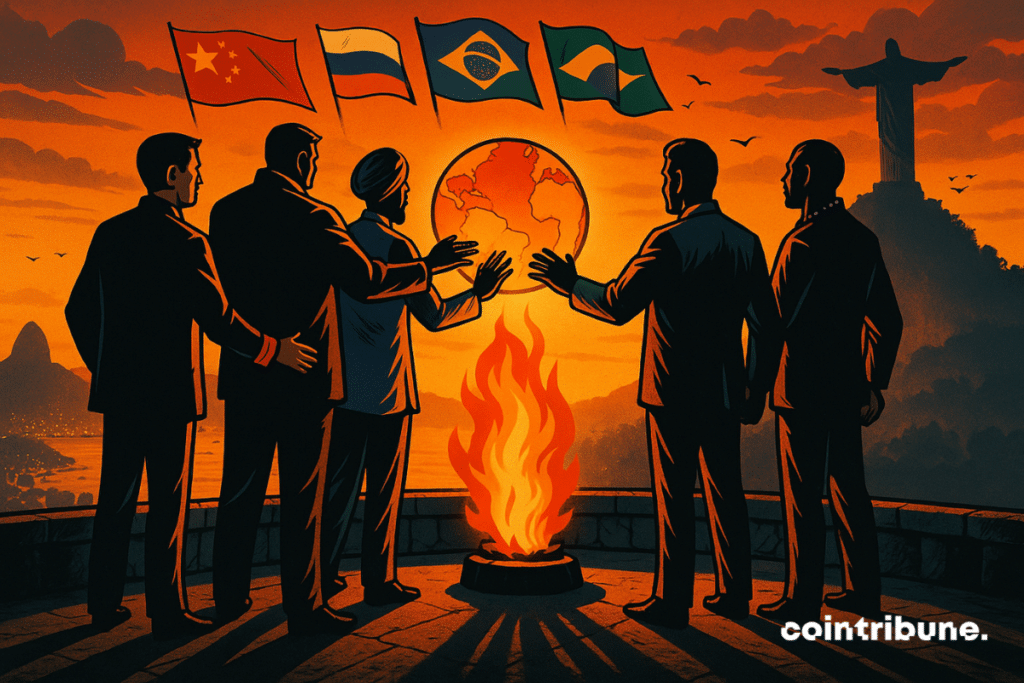BRICS in Rio: The Most Important Decisions Unveiled
As global balances are reshaped, the BRICS summit in Rio has outlined the contours of a more assertive multipolar influence. Behind the notable absence of Xi Jinping and Vladimir Putin, the discussions led to concrete proposals: reform of international institutions, strengthened climate cooperation, regulation of artificial intelligence. Less spectacular but more strategic, this edition provides insight into the ambitions of the global South, while revealing latent tensions that weaken the coherence of a bloc in search of credibility.

In brief
- The 2025 BRICS summit was held in Rio amidst high geopolitical expectations, despite the absence of Putin and Xi Jinping.
- The BRICS issued a joint declaration calling for reform of multilateral institutions, including the UN, IMF, and World Bank.
- The group supports the admission of Brazil and India to the UN Security Council to strengthen the representation of the global South.
- The summit marks a growing willingness of the BRICS to structure a lasting influence on the global chessboard, without direct confrontation with the West.
Reforming the world order: the global South’s assertive agenda
The BRICS summit, held in Rio, resulted in a joint declaration entitled “reinforcing global South cooperation for more inclusive and sustainable governance”, in which the members showed a renewed willingness to rethink the architecture of international governance.
The text notably calls for strengthening the representation of the global South within major multilateral institutions. The BRICS explicitly demand that Brazil and India gain permanent membership status on the UN Security Council, emphasizing the need “for UN system reform to make it more equitable, effective, and representative”.
Likewise, the declaration stresses the necessity of rebalancing decision-making power within the IMF and World Bank, stating that it is time to “review voting rights to reflect current economic realities”.
Beyond institutional demands, the final statement highlights several action areas shared by the group members, reflecting a desire to leverage their diplomatic weight on global issues. The main commitments made during the summit are as follows:
- Climate: adoption of a new cooperation framework ahead of COP30, to be held in Belém in November 2025. This framework aims to harmonize the global South’s positions on climate policies and increase their influence capacity in international negotiations.
- Technology: the BRICS advocate for a more inclusive global governance of artificial intelligence, believing that southern countries remain too marginalized in strategic discussions on standards, risks, and uses of this technology.
- Peace and security: the text calls for de-escalation of international tensions, condemning recent attacks on Iranian territory (a BRICS member) and attacks on Russian civilian infrastructure. It also expresses support for lasting peace in the Middle East, particularly Gaza.
Through this set of positions, the BRICS seek to establish themselves as a structured collective actor capable of influencing the rules of the global game without necessarily confronting Western powers head-on. This diplomatic consolidation strategy constitutes the first step toward international autonomy which, to become real, must now be embodied in tangible instruments.
A financial alternative in the making: the promise of BRICS Multilateral Guarantees
Beyond political demands, a quieter but potentially decisive point emerged from the discussions in Rio: the proposal to create an unprecedented mechanism called BRICS Multilateral Guarantees.
Inspired by the model of MIGA (Multilateral Investment Guarantee Agency of the World Bank), this project aims to provide investment guarantees for infrastructure and development projects in Southern countries.
The goal is clear: to reduce the political risk perceived by international investors and, in doing so, attract more capital to regions still considered too unstable or insecure. According to the statement, this structure is intended to “facilitate investment flows across the global South, including beyond the perimeter of BRICS countries”.
This project fits within a logic of disintermediation from major Western financial institutions but without a harsh break. The statement indeed specifies that it is not a tool exclusive to members, opening the way to broader cooperation.
This pragmatic approach reflects a form of economic realism: the BRICS, despite their desire for emancipation, are aware of the structural limits of their economies and seek mechanisms for gradual anchoring in global circuits. Still in embryonic form, the initiative should be the subject of in-depth discussions until 2026, under the future Indian presidency of the group.
This step toward a parallel financial architecture could have medium-term repercussions on how infrastructure projects are financed in the South. If realized, the initiative could offer a genuine alternative to guarantees provided by Western lenders, while strengthening the economic credibility of the BRICS. However, its success will depend on many factors: the volume of financial commitments, governance arrangements, and the ability to maintain cohesion among members with sometimes divergent interests. India, which will chair the group in 2026, will bear the heavy task of bringing this ambition to maturity.
Maximize your Cointribune experience with our "Read to Earn" program! For every article you read, earn points and access exclusive rewards. Sign up now and start earning benefits.
Diplômé de Sciences Po Toulouse et titulaire d'une certification consultant blockchain délivrée par Alyra, j'ai rejoint l'aventure Cointribune en 2019. Convaincu du potentiel de la blockchain pour transformer de nombreux secteurs de l'économie, j'ai pris l'engagement de sensibiliser et d'informer le grand public sur cet écosystème en constante évolution. Mon objectif est de permettre à chacun de mieux comprendre la blockchain et de saisir les opportunités qu'elle offre. Je m'efforce chaque jour de fournir une analyse objective de l'actualité, de décrypter les tendances du marché, de relayer les dernières innovations technologiques et de mettre en perspective les enjeux économiques et sociétaux de cette révolution en marche.
The views, thoughts, and opinions expressed in this article belong solely to the author, and should not be taken as investment advice. Do your own research before taking any investment decisions.